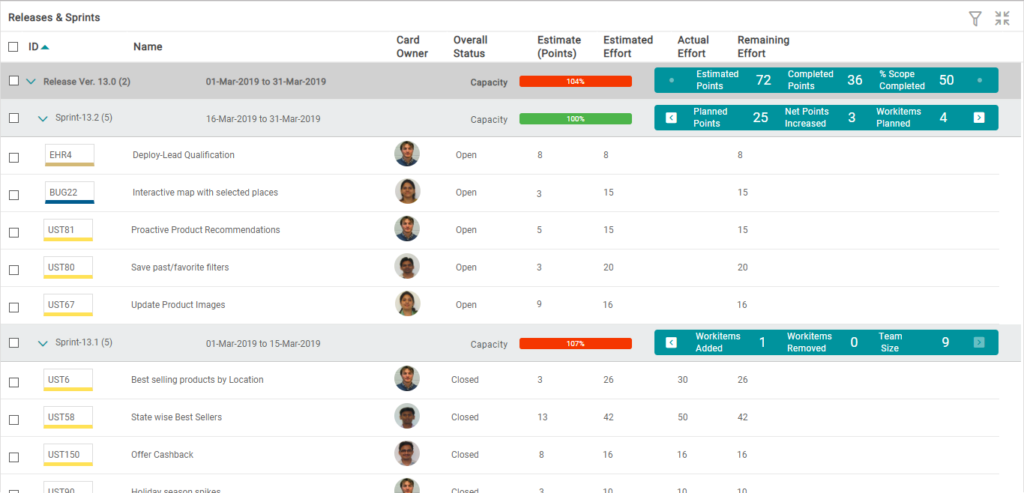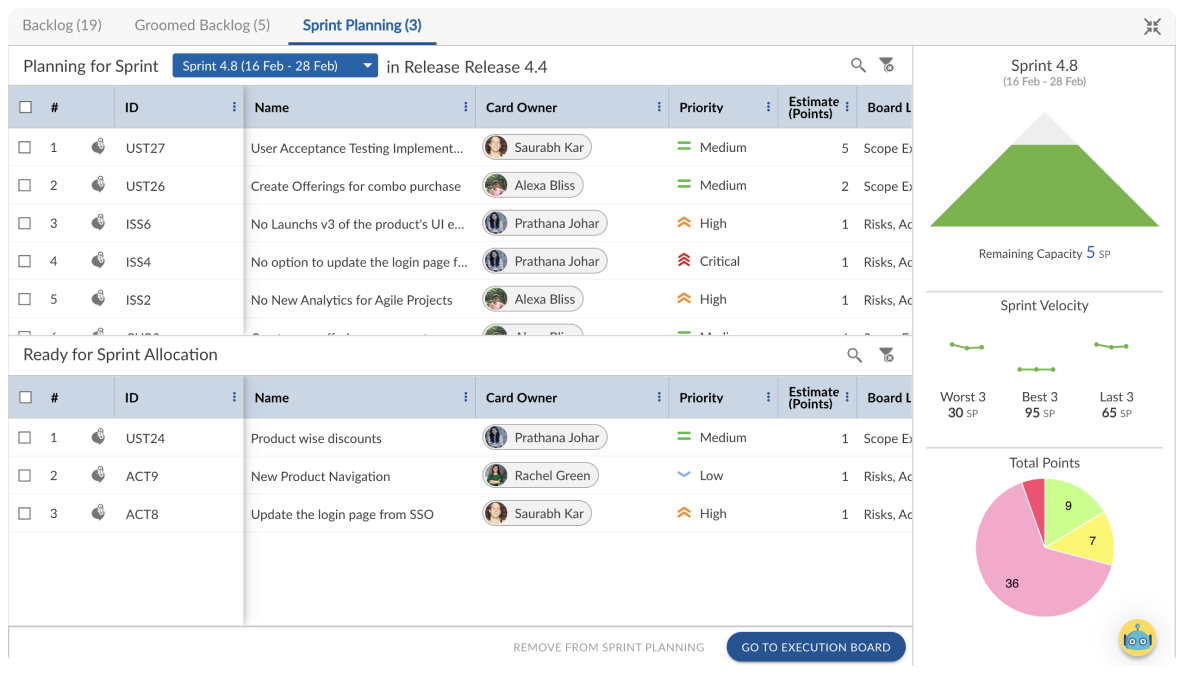What is Sprint Planning? How to do Effective Sprint Planning?
- 7 mins read
-
By Mahesh Singh
- Updated on September 2, 2024
Navigate to
Adopting Agile methodologies is critical for meeting new customer needs, changing direction based on evolving situations, or being responsive to market demands.
These methodologies focus on maximizing value to the end customer by building products in iterations – shorter cycles – to ensure that they meet the dynamic market needs. The project is broken down into smaller periods known as iterations or sprints. The overall project is delivered by completing these sprints in a sequence.
Instead of planning a large project, Agile teams plan one or a few sprints at a time (a few sprints are usually grouped into a Release or a Program Increment – PI). It is crucial to plan the sprints well.
Poor sprint planning can result in missed sprint scope, story leakage, and demotivation, causing unclear expectations for stakeholders and ultimately derailing critical projects.
Before starting the sprint, the team needs to collaborate, plan and schedule the exact work the team will do during the sprint. In this article, you’ll learn about sprint planning, how it works, and sprint planning best practices.
What is a sprint?
As mentioned earlier, every product development initiative using an Agile method, such as Scrum, comprises multiple sprints.
A sprint in Scrum is a “time-boxed” (meaning time-limited) iteration in which some planned work is completed and made available to the customer. In a single sprint, teams focus on providing a specific set of product features for the overall project.
Delivering some working features in each sprint enables the team to deliver value more frequently, get customer feedback faster, make course corrections if needed, and ultimately, deliver a product that satisfies the customer.
This is Agile’s – and Sprint-based developments – fundamental goal. Breaking down the project into sprints helps deliver the working product faster, gain valuable customer feedback and quickly make the required changes.
The majority of sprints range from 2 to 4 weeks – although teams are free to define longer or shorter sprints based on their business need and capability.
What is Sprint Planning?
The sprint planning meeting outlines the scope and plan – including specific activities, such as a stakeholder demo, for the upcoming sprint.
In a sprint planning meeting:
-
The specific tasks to be completed are identified and added to the sprint backlog
-
The time duration of the sprint is outlined, which can range from 2 to 4 weeks. However, once a sprint cycle is defined, this is typically kept constant for the duration of the project.
-
The overall roadmap, strategies, and steps to be undertaken are discussed and updated – as also, the sprint scope and deliverables.
When is Sprint Planning done?
Sprint planning meetings are done on the first day of the sprint. This is ideally done after the previous sprint retrospective is complete.
A sprint retrospective is a team event that happens after the previous sprint is over. It is an event where team members review and discuss the recently finished sprint.
They gain valuable insights and lessons that can be used to make the upcoming sprints more effective. Finally, team members agree on the core priorities and finalize the product backlog items to be worked upon during the ongoing sprint.
Teams can schedule the sprint planning sessions at a regular time slot every week or month. Then they can prioritize the sessions and parallelly complete other engagements.
Who does Sprint Planning?
-
Product Owner: The Product Owner clarifies the sprint goals and lists the backlog items/tasks (the features or user stories) the team needs to complete. They also prioritize the backlog items to ensure that they are taken up in the right order..
-
Scrum Master: The Scrum Master is the Agile coach who facilitates the sprint planning meeting. They organize the sprint workload, answer questions about the project/ sprint goals and make the required resources available to the team.
-
The (Development) Team: In the context of product development, it is the Dev team, while if it were an Agile Marketing team, it would just be the team. The team members contribute to the sprint planning meeting by outlining estimated time frames for backlog items. They commit to getting the work done and highlight any skill or resource gaps that can be a barrier to completing the sprint.
Sizing and Estimation in Sprint Planning
For successful sprints, it is essential to have a clear sprint planning agenda. It keeps the team focused on the sprint objectives, organizes the deliverables, and avoids the wastage of resources.
A sprint planning session includes:
-
Sprint goal: The product owner describes the sprint goal and the backlog items critical to its achievement. Then, the rest of the team decides the backlog items that can be realistically completed in this sprint.
-
Sizing the sprint backlog: Once the sprint goals are clear, the team works together and reviews the backlog. Sizing the backlog items is essential. The most common approach to story sizing is Relative Story Sizing, which is measured in terms of Story Points. A popular technique used for Story Sizing is called “planning poker,” where each story is assigned a number that follow the Fibonacci series starting with 1. Others may use a simpler “t-shirt sizing” in terms of Extra Small (XS) through Medium all the way to Extra Large (XL) or more.
Teams may use historical data to see if the backlog items can be completed in the sprint. If the user stories are too large for a single sprint, they need to be broken down into smaller user stories that are valid and can be completed independently.
Next, they prioritize the items to see which ones are critical and need to be worked on now and add them to the sprint backlog. The less critical stories that can be performed later may be moved back to the product backlog (to be worked on in later sprints). Any important items missed in the previous sprint which must be completed are added to the sprint backlog.
-
Estimating user stories: In this step, the team’s availability and capacity to comfortably complete the sprint backlog are reviewed and aligned to the backlog items due for completion. Team members collaborate to break down each story into tasks and estimate the effort required to complete it in hours. (However, many Agile teams are now moving away from this level of estimation – and simply stay with story-level sizing in terms of story-points).
-
Assumptions, dependencies, and risks: For the success of the sprint, it is essential to assess the overall project carefully to notice any interdependencies and risks that may impact sprint progress. The team also identifies assumptions made in the sprint plan and allows for necessary workarounds to ensure that the sprint stays on track.
What are the outcomes of the Sprint Plan?
Agile teams must lay down the sprint plan outcomes to have successful sprints.
The entire team needs to discuss, outline and finalize the sprint goal and sprint backlog before starting the sprint. It happens in a planned cadence – at the start of every sprint.
Sprint goal: The sprint goal is the purpose of planning and executing the sprint. This could be one single or a specific set of features for the product under development based on its nature and scope.
Sprint backlog: The sprint backlog includes all the user stories the team will work on during the sprint. This is a list of user stories (and often defects identified by customers or internal teams) that need to be completed during the Sprint in order to advance the overall project.
Sprint Planning Best Practices
Based on our own experience and that of our customers, the following sprint planning best practices are worth a read to ensure that your sprint stays organized and goes as per plan:
-
Prioritize the product backlog to ensure it is up-to-date, relevant, and accurate
-
Clarify the sprint length to help the team understand the timelines. Usually sprints are between 2 and 4 weeks – and once decided, they remain the same for a team or a department.
-
Request team members to come prepared with relevant data for sprint planning
-
Define the sprint planning goals clearly for team understanding
-
Position a leader for the sprint who acts as a facilitator to guide the team and better distribute the workload
-
Focus on functionalities that provide value to the end-users rather than simply checking off tasks in the to-do list
-
Schedule a question-and-answer session at the end of the sprint planning session to clarify questions
-
Learn from previous sprint retrospectives and apply them to improve upcoming sprints
Sprint Planning in a distributed team environment
Given the distributed nature of the modern organization, and the new hybrid world we find ourselves in, Sprint planning often needs to be done virtually – using web-based apps and collaboration tools such as Zoom or Teams.
Having a powerful, yet intuitive and configurable tool for planning and managing your overall releases, projects and sprints is most important.
Tools such as Nimble, with versatile backlog grooming, sprint planning, and execution capabilities as well as powerful metrics can be invaluable in getting the entire team and all the stakeholders on the same page with respect to the plan and the real-time status of a sprint as well as the overall project.
In summary, a Sprint represents a small project that needs to be scoped and planned well, and executed even better. A 2-4 week timeline passes pretty quickly and it comes time to make the sprint delivery and move on to the next Sprint.
With a good understanding of the overall process and a set of good tools to manage the overall project/ product or a marketing strategy, effective Sprint Planning can be a breeze!
About Author:
Agile 101
What is an Agile Epic? Benefits of Using Them
Learn what an Agile epic is, how it can streamline project management, and the benefits of incorporating epics into your Agile workflow.
Is Hybrid Agile Right for your Team? Here’s what you need to know
Explore the suitability of Hybrid Agile for your project needs in our comprehensive article. We delve into the benefits, considerations, and key factors to help you determine if this approach aligns with your organization’s goals and project requirements.
What is Hybrid Agile Project Management? A Short Guide
Discover the power of Hybrid Agile project management: achieve flexibility and structure for successful project execution. Learn how to harness this dynamic approach.
Dynamic System Development Method (DSDM)
Dynamic Systems Development Method, DSDM for short, seeks to do what came to be known as ‘Agile’ well before the manifesto was written. Learn more about its philosophy, principles, pillars, and practices.
What is Scrum Methodology? An Introduction for Agile Teams
Scrum is an agile project management framework that prioritizes collaboration and iterative development for efficient results.
Scrum of Scrums: A Starting Point to Scaling Agile
Scrum of scrums is an approach to coordinate multiple scrum teams working together. Learn how it works, how to get started and how it differs from competing approaches.
Pair programming is a programming method in which two people work together on a single program. The first person is the “Driver”, who writes the code, the other person is the “Navigator” who reviews each line of code as it is typed, checking for errors. They exchange their roles on a regular basis.
Code refactoring in Agile is a well-known technique to keep a codebase healthy and amenable to change. Learn what it is and a sound process to follow.
Speed up your Agile planning and execution!
Signup for a FREE Trial of Nimble Agile




